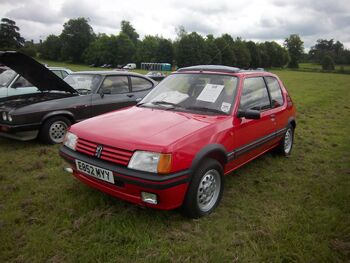
1988 Peugeot 205 GTI
The Peugeot 205 is a supermini produced by the French car manufacturer Peugeot between 1983 and 1998. It was declared 'Car of the Decade' by CAR magazine in 1990. The 205 won 1984 What Car? car of the year.
History[]
The styling of the 205 is often thought to be a Pininfarina design, however Gerard Welter claims it as an in-house; Pininfarina only styled the Cabriolet. It is often credited as the car which turned Peugeot's fortunes around. Before the 205, Peugeot was considered the most conservative of France's "big three" car manufacturers, producing large saloons such as the 504 and 505. The genesis of the 205 lay within Peugeot's takeover in 1978 of Simca, which had the necessary expertise in making small cars. Early 205s used the "Douvrin" engine from the older Peugeot 104, although these were later replaced with the newer XU and TU-series engines, which were of PSA design. Engines ranged from 954 cc to 1905 cc engine displacement, in carburetor or fuel injected petrol and diesel versions. Its use of the now standard PSA Peugeot Citroën suspension layout of Macpherson struts at the front, with torsion bar suspension rear suspension, that debuted in the Peugeot 305 estate, was a key ingredient of the success of the 205. This is fully independent using torsion bars (Torsion spring) and trailing arms. It is very compact and was designed to minimise suspension intrusion into the boot, giving a wide flat loadspace, while providing excellent ride and handling.
It was launched on 24 February 1983.
Shortly after its launch, it was narrowly pipped to the European Car of the Year award by the similar sized Fiat Uno, but ultimately (according to the award organizers) it would enjoy a better image and a longer high market demand than its Italian competitor.
The diesel models employed the XUD PSA Diesel inline-four engine, lifted from the Citroën BX which was introduced in 1982. These XUD engines has a capacity of 1769 cc (XUD7) and 1905 cc (XUD9) and are closely related to the XU5 and XU9 petrol engines in the BX16 and BX19 of the time respectively, as well as the engines later used in the 205 GTI 1.6 and Automatic (also 1.6) and GTI 1.9 respectively (other Peugeot/Citroën [PSA] products, such as the 305 and Talbot Horizon as well as the BX, used the XUD9 1905 cc Diesel engine of the same capacity as the 205 GTI 1.9 and Citroën BX 19 petrol engined models). The XUD7 (and XUD9) Diesel Engines were world-beating and so petrol-like that many buyers were won over by petrol car performance combined with diesel economy. The 205 GRD (1.8 Diesel, 59 bhp (44 kW), 78 lb·ft (105.8 N·m)), for instance, was as fast yet smoother than the 205 GR (1.4 Petrol, 59 bhp (44 kW), 78 lb·ft (105.8 N·m)), due to the engine developing peak torque at much lower rpm, while using much less fuel.
There were also various versions intended for commercial use, such as the two-seater XA-series. There was also the "205 Multi", a tall-bodied special version on XA or XE-basis built by independent coachbuilders like Gruau and Durisotti. Gruau called their XA-based two-seater version the "VU", while the five-seat XE-based version was called the "VP". Durisotti began building the 205 Multi in 1986; it was called the "205 Multi New Look".









